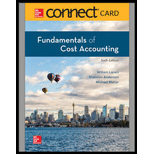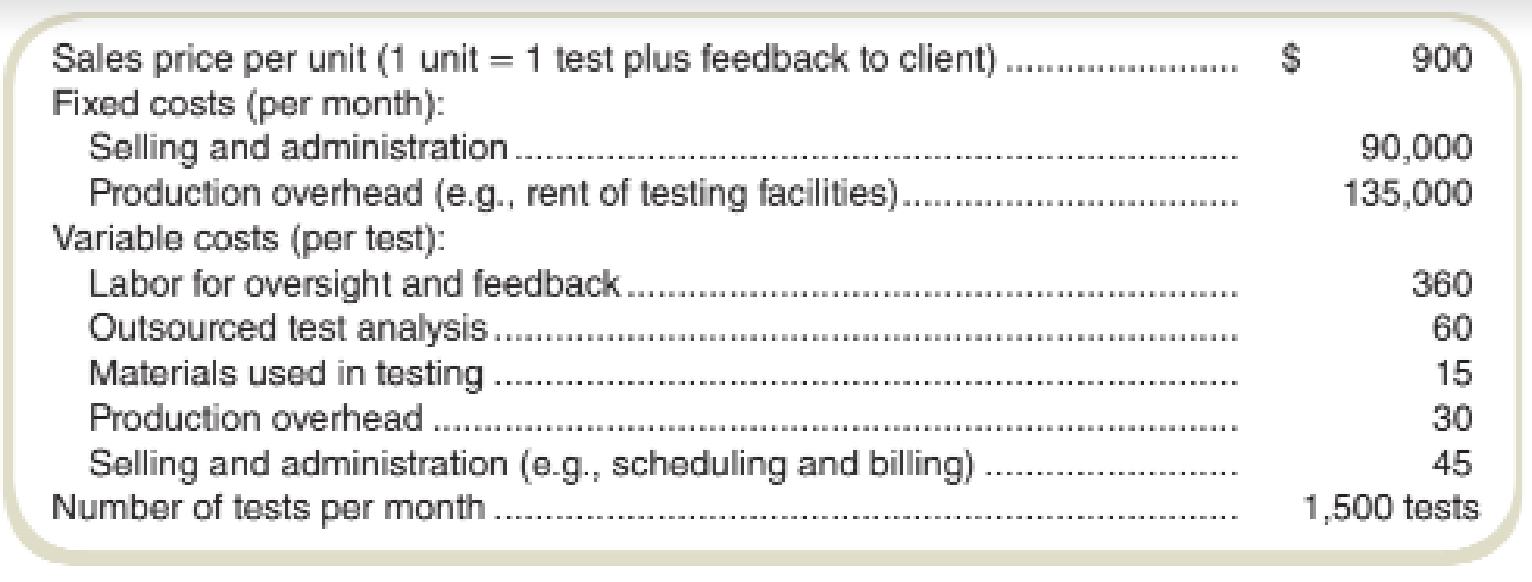
Concept explainers
Basic Concepts
The following data apply to the provision of psychological testing services:

Required
Give the amount for each of the following (one unit = one test):
- a. Variable production cost per unit.
- b. Variable cost per unit.
- c. Full cost per unit.
- d. Full absorption cost per unit.
- e. Prime cost per unit.
- f. Conversion cost per unit.
- g. Contribution margin per unit.
- h. Gross margin per unit.
- i. Suppose the number of units decreases to 1,250 tests per month, which is within the relevant range. Which parts of (a) through (h) will change? For each amount that will change, give the new amount for a volume of 1,250 tests.
a.
Calculate the variable production cost per unit.
Answer to Problem 34E
The total variable production cost per unit is $465.
Explanation of Solution
Production cost per unit:
The production cost per unit refers to the unit cost of production including direct materials, direct labor and manufacturing overheads.
Compute the variable production cost per unit:
| Particulars | Amount |
| Variable costs (per test): | |
| Labor for oversight and feedback | $360 |
| Outsourced test analysis. | $60 |
| Materials used in testing | $15 |
| Production overhead | $30 |
| Total variable production cost per unit | $465 |
Table: (2)
Thus, the total variable production cost per unit is $465.
b.
Calculate the variable cost per unit.
Answer to Problem 34E
The variable cost per unit is $510.
Explanation of Solution
Variable cost per unit:
The variable cost per unit refers to the unit variable cost of product including the variable manufacturing costs.
Compute the variable cost per unit:
| Particulars | Amount |
| Variable costs (per test): | |
| Labor for oversight and feedback | $360 |
| Outsourced test analysis. | $60 |
| Materials used in testing | $15 |
| Production overhead | $30 |
| Selling and administration (e.g., scheduling and billing) | 45 |
| Total variable cost | $510 |
Table: (4)
Thus, the total variable cost per unit is $510.
c.
Calculate the full cost per unit.
Answer to Problem 34E
The full cost per unit is $660.
Explanation of Solution
Full cost per unit:
The full cost per unit refers to the total cost of the product including the fixed and variable cost per unit.
Compute the full cost per unit:
Thus, total cost per unit is $660.
Working note 1:
Compute the total fixed cost:
| Particulars | Amount |
| Fixed costs (per month): | |
| Selling and administration | $90,000 |
| Production overhead (e.g., rent of testing facilities) | $135,000 |
| Total fixed costs | $225,000 |
Table: (6)
Working note 2:
Compute the fixed cost per unit:
Working note 3:
Compute the variable cost per unit:
| Particulars | Amount |
| Variable costs (per test): | |
| Labor for oversight and feedback | $360 |
| Outsourced test analysis. | $60 |
| Materials used in testing | $15 |
| Production overhead | $30 |
| Selling and administration (e.g., scheduling and billing) | 45 |
| Total variable cost | $510 |
Table: (7)
d.
Calculate the full absorption cost per unit.
Answer to Problem 34E
The full absorption cost per unit is $555.
Explanation of Solution
Full absorption cost per unit:
the full absorption cost per unit refers to the total unit cost including the fixed manufacturing overhead and variable cost per unit.
Calculate the full absorption cost per unit:
Thus, full absorption cost per unit is $555.
Working note 4:
Compute the fixed manufacturing overhead per unit:
Working note 5:
Compute the variable production cost per unit:
| Particulars | Amount |
| Variable costs (per test): | |
| Labor for oversight and feedback | $360 |
| Outsourced test analysis. | $60 |
| Materials used in testing | $15 |
| Production overhead | $30 |
| Total variable production cost per unit | $465 |
Table: (8)
e.
Calculate the prime cost per unit.
Answer to Problem 34E
The prime cost per unit is $435.
Explanation of Solution
Prime cost per unit:
The cost including materials cost per unit, labor cost per unit and outsource cost per unit refers to the prime cost per unit.
Calculate the prime cost per unit:
Thus, prime cost per unit is $435.
f.
Calculate Conversion cost per unit.
Answer to Problem 34E
The Conversion cost per unit is $540.
Explanation of Solution
Conversion cost per unit:
The conversion cost per unit refers to the total unit cost of labor, outsourcing and production overhead.
Calculate the Conversion cost per unit:
Thus, conversion cost per unit is $540.
Working note 6:
Calculate the production overhead per unit:
Working note 7:
Calculate the fixed production overhead per unit:
g.
Calculate Contribution margin per unit.
Answer to Problem 34E
The Contribution margin per unit is $390.
Explanation of Solution
Contribution margin per unit:
The contribution margin per unit refers to the difference between sales price per unit and the variable cost per unit. The contribution margin as a percentage of sales is referred to as the contribution margin ratio (CM ratio).
Calculate the contribution margin per unit:
Thus, contribution margin per unit is $390.
h.
Calculate gross margin per unit.
Answer to Problem 34E
The gross margin per unit is $345.
Explanation of Solution
Gross margin per unit:
The gross margin per unit is the difference of selling price per unit and the absorption cost per unit.
Calculate the gross margin per unit:
Thus, the gross margin per unit is $345.
i.
Calculate the change required in parts (a) through (h). given that the new amount for a volume of 1,250 units.
Answer to Problem 34E
- I. Total cost per unit is $690.
- II. Full absorption cost per unit is $573.
- III. Conversion cost per unit is $558.
- IV. The gross margin per unit is $327.
Explanation of Solution
I.
Calculate the change in fixed cost because of decrease in units to 1,250:
Compute the total cost per unit:
Thus, total cost per unit is $690.
Working note 8:
Compute the fixed cost per unit:
II.
Calculate the change in full absorption because of decrease in units to 1,250:
Thus, full absorption cost per unit is $573.
Working note 9:
Compute the fixed manufacturing overhead per unit:
Thus, fixed manufacturing overhead per unit is $108.
III.
Calculate the change in conversion cost because of decrease in units to 1,250:
Thus, conversion cost per unit is $558.
Working note 10:
Calculate the production overhead per unit:
IV.
Calculate the change in gross margin because of decrease in units to 1,250:
Thus, the gross margin per unit is $327.
Want to see more full solutions like this?
Chapter 2 Solutions
Connect Access Card For Fundamentals Of Cost Accounting
- Fairfield Company's payroll costs for the most recent month are summarized here: Item Hourly labor unges Description 920 hours $27 per hour 190 hours for Job 101 340 hours for Job 102 Factory supervision Production engineer Factory Janitorial work Selling, general, and administrative salaries Total payroll costs Required: 390 hours for Job 103 Total Cost $ 5,130 9,180 10,530 $ 24,840 4,350 7,100 1,200 8,800 $ 46,298 1. & 2. Prepare the journal entries for payroll and to apply manufacturing overhead to production. The company applies manufacturing overhead to products at a predetermined rate of $54 per direct labor hour Note: If no entry is required for a transaction/event, select "No Journal Entry Required" in the first account field. View transaction list Journal entry worksheet A B Record Fairfield Company's payroll costs to be paid at a later date. Note Enter debits before credits. S.No Date 1 Account Title Debit Creditarrow_forwardNo wrong answerarrow_forwardL.L. Bean operates two factories that produce its popular Bean boots (also known as "duck boots") in its home state of Maine. Since L.L. Bean prides itself on manufacturing its boots in Maine and not outsourcing, backorders for its boots can be high. In 2014, L.L. Bean sold about 450,000 pairs of the boots. At one point during 2014, it had a backorder level of about 100,000 pairs of boots. L.L. Bean can manufacture about 2,200 pairs of its duck boots each day with its factories running 24/7. In 2015, L.L. Bean expects to sell more than 500,000 pairs of its duck boots. As of late November 2015, the backorder quantity for Bean Boots was estimated to be about 50,000 pairs. Question: Now assume that 5% of the L.L. Bean boots are returned by customers for various reasons. L. Bean has a 100% refund policy for returns, no matter what the reason. What would the journal entry be to accrue L.L. Bean's sales returns for this one pair of boots?arrow_forward
- The following data were taken from the records of Splish Brothers Company for the fiscal year ended June 30, 2025. Raw Materials Inventory 7/1/24 $58,100 Accounts Receivable $28,000 Raw Materials Inventory 6/30/25 46,600 Factory Insurance 4,800 Finished Goods Inventory 7/1/24 Finished Goods Inventory 6/30/25 99,700 Factory Machinery Depreciation 17,100 21,900 Factory Utilities 29,400 Work in Process Inventory 7/1/24 21,200 Office Utilities Expense 9,350 Work in Process Inventory 6/30/25 29,400 Sales Revenue 560,500 Direct Labor 147,550 Sales Discounts 4,700 Indirect Labor 25,360 Factory Manager's Salary 63,400 Factory Property Taxes 9,910 Factory Repairs 2,500 Raw Materials Purchases 97,300 Cash 39,200 SPLISH BROTHERS COMPANY Income Statement (Partial) $arrow_forwardNo AIarrow_forwardL.L. Bean operates two factories that produce its popular Bean boots (also known as "duck boots") in its home state of Maine. Since L.L. Bean prides itself on manufacturing its boots in Maine and not outsourcing, backorders for its boots can be high. In 2014, L.L. Bean sold about 450,000 pairs of the boots. At one point during 2014, it had a backorder level of about 100,000 pairs of boots. L.L. Bean can manufacture about 2,200 pairs of its duck boots each day with its factories running 24/7.In 2015, L.L. Bean expects to sell more than 500,000 pairs of its duck boots. As of late November 2015, the backorder quantity for Bean Boots was estimated to be about 50,000 pairs. Question: Assume that a pair of 8" Bean Boots are ordered on December 3, 2015. The order price is $109. The sales tax rate in the state in which the boots are order is 7%. L.L. Bean ships the boots on January 29, 2016. Assume same-day shipping for the sake of simplicity. On what day would L.L. Bean recognize the…arrow_forward
 Principles of Cost AccountingAccountingISBN:9781305087408Author:Edward J. Vanderbeck, Maria R. MitchellPublisher:Cengage LearningPrinciples of Accounting Volume 2AccountingISBN:9781947172609Author:OpenStaxPublisher:OpenStax College
Principles of Cost AccountingAccountingISBN:9781305087408Author:Edward J. Vanderbeck, Maria R. MitchellPublisher:Cengage LearningPrinciples of Accounting Volume 2AccountingISBN:9781947172609Author:OpenStaxPublisher:OpenStax College

